Graphene Battery 2025: Breakthroughs, Safety & Future Applications
Graphene batteries promise faster charging, longer life, and enhanced safety by leveraging graphene’s extraordinary electrical and thermal properties. This 2025 guide explains how graphene batteries work, where they’re used, and what’s new in research and commercialization.
Whether you’re an EV enthusiast, a hardware engineer, or a curious reader, you’ll find clear, up-to-date answers—plus a practical comparison with lithium-ion and solid-state technologies.
What Is a Graphene Battery?
A graphene battery is an energy-storage device that uses graphene—an atom-thin, hexagonally arranged layer of carbon—to enhance one or more battery components such as electrodes, current collectors, or additives. Graphene’s exceptional conductivity, high surface area, mechanical strength, and heat dissipation can improve charge rate, energy density, lifespan, and safety.
Most systems in 2025 are graphene-enhanced lithium-ion, lithium-sulfur, or sodium-ion cells rather than “pure graphene” chemistries. Improvements typically come from graphene-based anodes/cathodes, graphene coatings, or graphene current collectors that reduce internal resistance and better manage heat.
How Graphene Improves Battery Performance
Ion Transport & Charge Mechanism
In conventional lithium-ion electrodes, conductive additives create mostly “point-to-point” contacts. By contrast, graphene forms “plane-to-point” pathways that lower resistance and support rapid ion and electron transport. The result is higher power density and shorter charging times without sacrificing capacity.
Thermal & Electrical Conductivity
Graphene’s exceptional conductivity helps distribute current evenly and dissipate heat. Recent work on graphene current collectors reports very high in-plane thermal conductivity and robust cycling stability, supporting safer operation under high loads and fast-charge conditions.
Graphene in Anodes vs. Cathodes
- Anodes: Graphene or graphene-silicon composites can increase capacity and mitigate volume-change stress, improving cycle life.
- Cathodes: Graphene coatings enhance conductivity and reduce side reactions, improving rate capability and stability.
- Lithium-sulfur & sodium-ion: Graphene hosts and separators can suppress shuttle effects and strengthen kinetics.
Advantages of Graphene Batteries
- Faster charging: Lower internal resistance and efficient pathways enable rapid charge acceptance.
- High energy density: Optimized electrode designs and reduced inactive additives increase energy per weight and volume.
- Longer lifespan: Mechanical resilience and stable interfaces reduce degradation over many cycles.
- Improved safety: Better heat spreading and controlled surface reactions help reduce thermal-runaway risk.
- Lightweight & flexible: Thin, robust foils and films support flexible electronics and high-specific-energy designs.
At-a-Glance Comparison
| Attribute | Graphene-Enhanced (2025) | Conventional Li-ion | Solid-State (R&D/early) |
|---|---|---|---|
| Charging speed | Very fast (design-dependent) | Moderate–fast | Moderate (improving) |
| Energy density | High (cell-design dependent) | High (mature) | Potentially very high |
| Cycle life | Long (reduced degradation) | Good–excellent | Promising; varies by chemistry |
| Thermal safety | Enhanced heat dissipation | Good; needs management | Improved solid electrolyte |
| Manufacturing status | Pilots & early commercialization | Mass production | Pilots / limited commercialization |
Applications of Graphene Batteries
Electric Vehicles (EVs)
Graphene-enhanced cells target faster DC fast-charging, improved cold-temperature performance, and better thermal safety. As pack designs evolve, graphene current collectors and coatings can support higher power without excessive heat buildup.
Consumer Electronics
Phones, laptops, and wearables benefit from quick top-ups and improved cycle life. Thin, flexible graphene foils also support compact, high-specific-energy designs for slim devices.
Renewable-Energy Storage
In home and grid storage, robust cycle life and thermal stability are crucial. Graphene-based electrodes and collectors aim to reduce resistance, improving round-trip efficiency and power delivery.
Aerospace & Defense
Weight reduction, reliability, and high-power bursts are prized. Graphene’s strength-to-weight ratio and conductivity can enable lighter packs and resilient operation across temperature extremes.
Recent Research & Market Developments (2024–2025)
- Graphene current collectors: University-led teams reported scalable, defect-resistant graphene foils with exceptional in-plane thermal conductivity and endurance, supporting safer high-power operation.
- Electrode composites: Graphene-silicon anodes and graphene-coated cathodes continue to show improved rate capability and cycle stability in lab and pilot lines.
- Commercial pilots: Multiple battery and materials companies are trialing graphene-enhanced cells for EVs, consumer electronics, and stationary storage, focusing on manufacturability, consistency, and cost.
- Standardization: Industry groups are exploring test protocols for graphene materials to compare performance consistently across vendors.
Challenges & Limitations
- Production cost & scale: High-quality graphene (e.g., CVD routes) remains cost-sensitive; roll-to-roll processes and alternative synthesis aim to reduce costs.
- Process integration: Uniform dispersion/coating and compatibility with legacy slurry-casting lines require careful optimization.
- Standards & testing: Agreed definitions and metrics are still maturing, making cross-vendor comparisons difficult.
- Application fit: Not every use case benefits equally; designs must balance energy density, power, safety, cost, and lifetime.
Future Outlook & Commercialization Timeline
| Year | Milestone |
|---|---|
| 2004–2010 | Graphene isolation and foundational property research. |
| 2010–2020 | Early electrode additives, coin-cell demonstrations, improving rate performance. |
| 2021–2024 | Progress in scalable foils, coatings, and composite anodes; initial pilots in specialty devices. |
| 2025 | Pilots expand to EV, consumer, and stationary prototypes; growing focus on safety and manufacturing consistency. |
| 2026–2030 (forecast) | Wider commercialization in select segments as costs fall and standards improve; increased pairing with fast-charge infrastructure. |
Bottom line: Graphene will continue to roll out first as an enhancement—improving charge rate, safety, and cycle life—then expand to more platforms as supply chains and standards mature.
Frequently Asked Questions
- Are graphene batteries commercially available in 2025?
- Yes—primarily as graphene-enhanced cells (e.g., graphene coatings, additives, or current collectors) in pilots and early products. Availability varies by region and application.
- How fast can a graphene battery charge?
- Design-dependent. Graphene’s low resistance and heat spreading can enable significantly faster charge acceptance than comparable conventional cells, provided the pack and charger are engineered accordingly.
- Are graphene batteries safer than conventional lithium-ion?
- They can be. Enhanced thermal conductivity and controlled interfacial reactions reduce hot spots and help mitigate thermal-runaway risks—especially under fast-charge or high-power usage.
- What’s the difference between graphene and solid-state batteries?
- Graphene is a conductive carbon material used to improve electrodes or collectors in many chemistries. Solid-state replaces liquid electrolyte with a solid. The two approaches can be complementary rather than mutually exclusive.
- Which industries will adopt graphene batteries first?
- High-value segments that benefit from fast charging and heat management—premium consumer devices, performance EVs, aerospace/defense, and select stationary storage—are early candidates.
References
- U.S. Department of Energy – Energy.gov: “Graphene Material to Reduce Battery Charge Time” (2018).
- University press reports (2024): Scalable graphene foils/current collectors with high thermal conductivity for safer Li-ion operation.
- Peer-reviewed literature (2021–2025): Graphene-enhanced electrodes, lithium-sulfur mitigation via graphene hosts/separators, sodium-ion with graphene composites.
- Industry and market briefings (2024–2025): Pilot lines and early commercialization of graphene-enhanced cells across EV, consumer, and stationary storage.
Tip: For deeper background on graphene fundamentals, see our guides on Graphene Uses.




